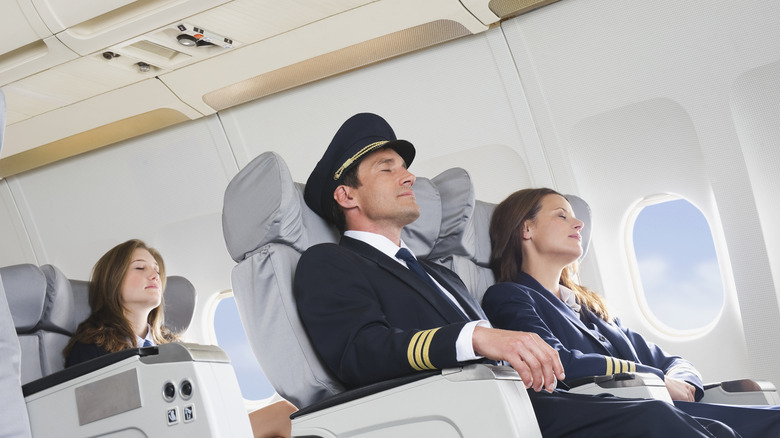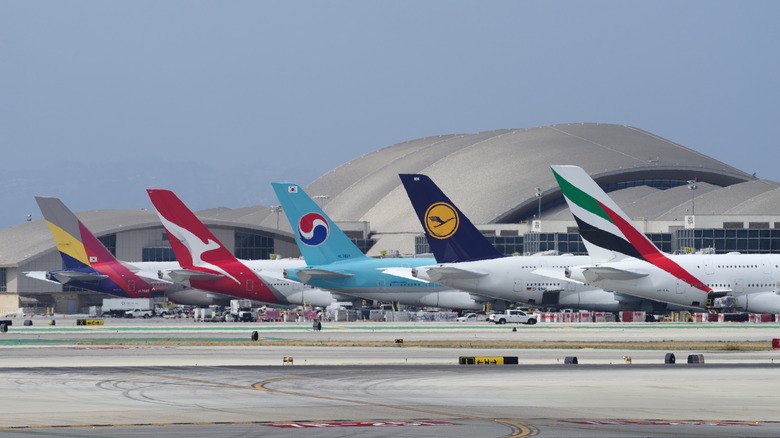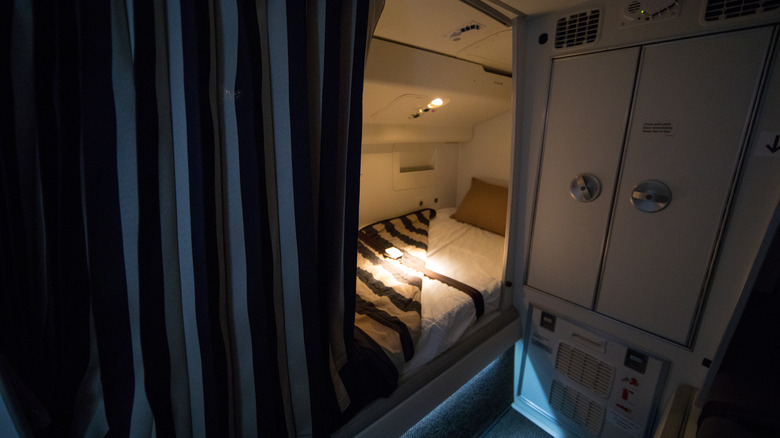Airplanes That Have Secret Bedrooms For Flight Attendants
Crews working long-haul flights often deal with hundreds of passengers that have different wants and needs, especially during some of the longest flights in the world. During critical safety phases, flight attendants are in their jump seats (and there's an unnerving reason why the crew sits on their hands during takeoff and landing). For long stretches in the air, members of the crew take turns flitting away to hidden spots on the aircraft to catch a bit of rest. These secret crew rest areas and compartments are common on larger planes that are used on long-range flights. They're off-limits to passengers, so staff can get the adequate rest or quiet time they need.
The Federal Aviation Administration (FAA) mandates that these areas protect against "intrusive noise, odors, and vibration" so that flight attendants and pilots can catch up on some sleep or just relax (via CNN). As such, these spaces are meant to be sterile break rooms. However, not all crew rest zones are as spiffy as others. Depending on the airplane's age and model, the hidden cabins can be configured in different ways. Some airplane crew rests are more comfortable and private than others, but overall, the aim of the space is to be a respite from passengers.
Long-range airplane models have different crew rest zone configurations
Though there are regulations set by the FAA for crew rest compartments, some older models of planes have different configurations that aren't as private or comfortable as their newer counterparts. For example, a Boeing 767, an older widebody aircraft model that first debuted in 1982, has crew rests that are likely just a series of recliner seats with curtains drawn around them. While the curtains are made out of a heavy-duty, blackout fabric, it doesn't stop a straying passenger from poking their head in, thinking they've approached the galley. Meanwhile, in the A330/A340, the crew rest is in the cargo hold, featuring recliner seats and one or two bunks.
The world's largest plane, the double-decker A380, has a whopping 12-berth design near the cargo hold on the first floor. The long-range Boeing 777's crew rest is above the passengers through a private staircase, often in the rear of the aircraft. Though the Boeing 787's crew rest is also accessed at the rear, it might win for the most creative hidden exit point; it has an emergency exit that leads straight to the passenger cabin via a fake overhead luggage compartment. Different airlines can reconfigure these compartments based on their unique needs, though the general location remains the same. For instance, Emirates, a big user of the A380, has arranged the downstairs compartments to accommodate their onboard bathrooms and showers.
What's a crew rest bunk actually like?
The configuration of crew rests are efficient and compact accommodations similar to those in a modern capsule hotel. They're typically a couple of bunk beds built like cubbies into a 35-cubic-feet space (an FAA regulation), with a mattress that needs to meet or exceed 78x30 inches. The FAA further mandates that crew rests need to be well-ventilated, equipped with emergency lighting, and isolated enough so the staff's break won't be disrupted. Pilots often have their own crew rests on the plane. They're much smaller than the rest of the flight crew's, featuring a single bed or set of bunks. It's also usually closer to the cockpit in case the off-duty pilot needs to quickly make their way back to the flight controls.
The end goal of a crew rest compartment's design is, ultimately, discretion. It's meant to blend in and not attract too much attention from passengers so that the crew can rest privately. Imagine being on your feet monitoring the safety, cleanliness, and comfort of the flight for as long as passengers are sitting. Flight attendants have an intensive job, and it's vital that the crew stay at the top of their game for everyone's best interest. To help make their job a little easier, avoid making this common mistake during the food service that flight attendants hate.


